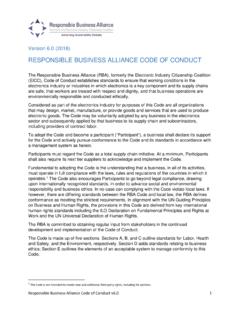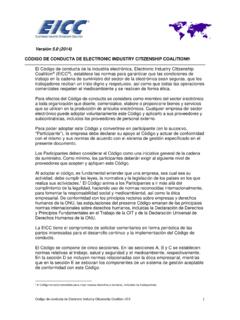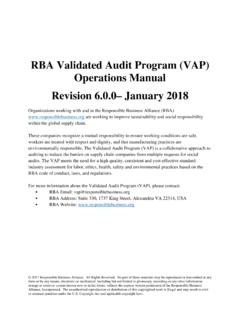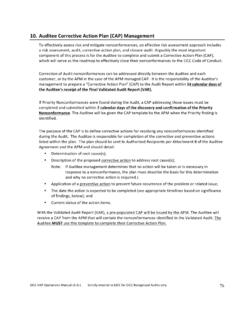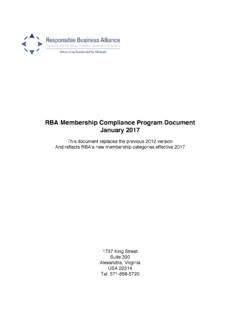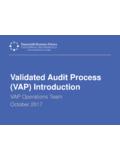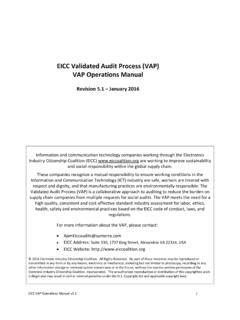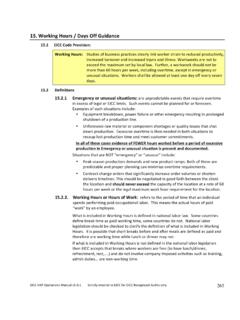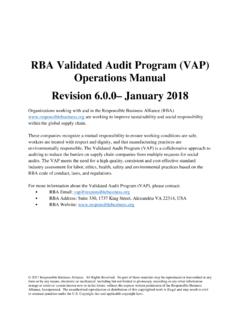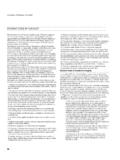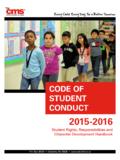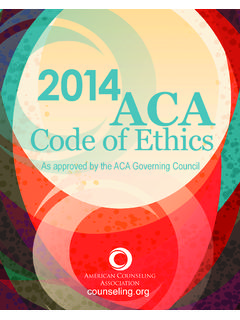Transcription of Version 5.0 (2014) ELECTRONIC INDUSTRY …
1 Version (2014). ELECTRONIC INDUSTRY CITIZENSHIP COALITION code OF conduct . The ELECTRONIC INDUSTRY Citizenship Coalition (EICC ) code of conduct establishes standards to ensure that working conditions in the electronics INDUSTRY supply chain are safe, that workers are treated with respect and dignity, and that business operations are environmentally responsible and conducted ethically. Considered as part of the electronics INDUSTRY for purposes of this code are all organizations that may design, market, manufacture or provide goods and services that are used to produce ELECTRONIC goods. The code may be voluntarily adopted by any business in the electronics sector and subsequently applied by that business to its supply chain and subcontractors, including providers of contract labor. To adopt the code and become a participant ( Participant ), a business shall declare its support for the code and actively pursue conformance to the code and its standards in accordance with a management system as herein.
2 Participants must regard the code as a total supply chain initiative. At a minimum, Participants shall also require its next tier suppliers to acknowledge and implement the code . Fundamental to adopting the code is the understanding that a business, in all of its activities, must operate in full compliance with the laws, rules and regulations of the countries in which it The code encourages Participants to go beyond legal compliance, drawing upon internationally recognized standards, in order to advance social and environmental responsibility and business ethics. In alignment with the UN. Guiding Principles on Business and Human Rights, the provisions in this code are derived from key international human rights standards including the ILO Declaration on Fundamental Principles and Rights at Work and the UN Universal Declaration of Human Rights. The EICC is committed to obtaining regular input from stakeholders in the continued development and implementation of the code of conduct .
3 The code is made up of five sections. Sections A, B, and C outline standards for Labor, Health and Safety, and the Environment, respectively. Section D adds standards relating to business ethics; Section E outlines the elements of an acceptable system to manage conformity to this code . 1. The code is not intended to create new and additional third party rights, including for workers. ELECTRONIC INDUSTRY Citizenship Coalition code of conduct 1. A. LABOR. Participants are committed to uphold the human rights of workers, and to treat them with dignity and respect as understood by the international community. This applies to all workers including temporary, migrant, student, contract, direct employees, and any other type of worker. The recognized standards, as set out in the annex, were used as references in preparing the code and may be a useful source of additional information.
4 The labor standards are: 1) Freely Chosen Employment Forced, bonded (including debt bondage) or indentured labor, involuntary prison labor, slavery or trafficking of persons shall not be used. This includes transporting, harboring, recruiting, transferring or receiving persons by means of threat, force, coercion, abduction or fraud for labor or services. There shall be no unreasonable restrictions on workers' freedom of movement in the facility in addition to unreasonable restrictions on entering or exiting company-provided facilities. As part of the hiring process, workers must be provided with a written employment agreement in their native language that contains a description of terms and conditions of employment prior to the worker departing from his or her country of origin. All work must be voluntary and workers shall be free to leave work at any time or terminate their employment.
5 Employers and agents may not hold or otherwise destroy, conceal, confiscate or deny access by employees to employees'. identity or immigration documents, such as government-issued identification, passports or work permits, unless the holding of work permits is required by law. Workers shall not be required to pay employers or agents recruitment fees or other aggregate fees in excess of one month's salary. All fees charged to workers must be disclosed and fees in excess of one month's salary must be returned to the worker. 2) Young Workers Child labor is not to be used in any stage of manufacturing. The term child refers to any person under the age of 15, or under the age for completing compulsory education, or under the minimum age for employment in the country, whichever is greatest. The use of legitimate workplace learning programs, which comply with all laws and regulations, is supported.
6 Workers under the age of 18 (Young Workers). shall not perform work that is likely to jeopardize their health or safety, including night shifts and overtime. Participant shall ensure proper management of student workers through proper maintenance of student records, rigorous due diligence of educational partners, and protection of students' rights in accordance with applicable law and regulations. Participant shall provide appropriate support and training to all student workers. In the absence of local law, the wage rate for student workers, interns and apprentices shall be at least the same wage rate as other entry-level workers performing equal or similar tasks. ELECTRONIC INDUSTRY Citizenship Coalition code of conduct 2. A. LABOR (con't.). 3) Working Hours Studies of business practices clearly link worker strain to reduced productivity, increased turnover and increased injury and illness.
7 Workweeks are not to exceed the maximum set by local law. Further, a workweek should not be more than 60. hours per week, including overtime, except in emergency or unusual situations. Workers shall be allowed at least one day off every seven days. 4) Wages and Benefits Compensation paid to workers shall comply with all applicable wage laws, including those relating to minimum wages, overtime hours and legally mandated benefits. In compliance with local laws, workers shall be compensated for overtime at pay rates greater than regular hourly rates. Deductions from wages as a disciplinary measure shall not be permitted. For each pay period, workers shall be provided with a timely and understandable wage statement that includes sufficient information to verify accurate compensation for work performed. All use of temporary, dispatch and outsourced labor will be within the limits of the local law.
8 5) Humane Treatment There is to be no harsh and inhumane treatment including any sexual harassment, sexual abuse, corporal punishment, mental or physical coercion or verbal abuse of workers; nor is there to be the threat of any such treatment. Disciplinary policies and procedures in support of these requirements shall be clearly defined and communicated to workers. 6) Non-Discrimination Participants should be committed to a workforce free of harassment and unlawful discrimination. Companies shall not engage in discrimination based on race, color, age, gender, sexual orientation, gender identity and expression, ethnicity or national origin, disability, pregnancy, religion, political affiliation, union membership, covered veteran status, protected genetic information or marital status in hiring and employment practices such as wages, promotions, rewards, and access to training.
9 Workers shall be provided with reasonable accommodation for religious practices. In addition, workers or potential workers should not be subjected to medical tests or physical exams that could be used in a discriminatory way. 7) Freedom of Association In conformance with local law, participants shall respect the right of all workers to form and join trade unions of their own choosing, to bargain collectively and to engage in peaceful assembly as well as respect the right of workers to refrain from such activities. Workers and/or their representatives shall be able to openly communicate and share ideas and concerns with management regarding working conditions and management practices without fear of discrimination, reprisal, intimidation or harassment. ELECTRONIC INDUSTRY Citizenship Coalition code of conduct 3. B. HEALTH and SAFETY. Participants recognize that in addition to minimizing the incidence of work-related injury and illness, a safe and healthy work environment enhances the quality of products and services, consistency of production and worker retention and morale.
10 Participants also recognize that ongoing worker input and education is essential to identifying and solving health and safety issues in the workplace. Recognized management systems such as OHSAS 18001 and ILO Guidelines on Occupational Safety and Health were used as references in preparing the code and may be a useful source of additional information. The health and safety standards are: 1) Occupational Safety Worker exposure to potential safety hazards ( , electrical and other energy sources, fire, vehicles, and fall hazards) are to be controlled through proper design, engineering and administrative controls, preventative maintenance and safe work procedures (including lockout/tagout), and ongoing safety training. Where hazards cannot be adequately controlled by these means, workers are to be provided with appropriate, well-maintained, personal protective equipment and educational materials about risks to them associated with these hazards.
